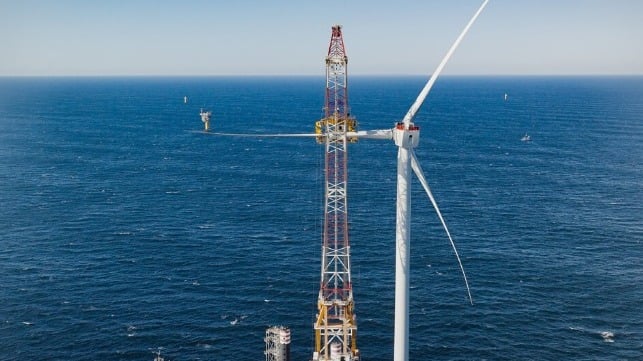South Fork Wind Becomes First Large U.S. Wind Farm to Deliver Power

New York’s South Fork Wind marked the delivery of its first power achieving a milestone for the beleaguered industry that is facing well-publicized financial and operational challenges. While smaller in scale at just 12 turbines to generate approximately 130 megawatts, it is still considered to be the first commercial-scale wind farm in the United States.
The project, which is a joint venture between Ørsted and Eversource, is located approximately 35 miles offshore from Montauk, New York on the eastern tip of Long Island. It has completed the installation of its first two turbines, with one operational, and expects to complete the installation of the 12 turbines by early 2024. When fully operational, they expect the wind farm will power about 70,000 homes.
Officials noted that it was nearly eight years in the making to reach this point. The project was first approved by the Long Island Power Authority in 2017 two years after they issued the first request for proposal. The federal site review was completed in 2017 and the project spent between 2018 and 2020 working on its construction and operating plan before gaining final federal approval in January 2022.
With offshore work beginning in 2023, the wind farm marked several key milestones. Boskalis's Bokalift 2, handled the foundation installation with the first steel entering the water in June. The wind farm also has the first U.S.-built offshore wind substation. Weighing 1,500 tons and standing 60 feet, it was built in Texas by Kiewit Offshore Services and after being completed in May was shipped to the site for installation.
“South Fork Wind is not just a trailblazing project for the state, it’s also one of the foundations of America’s offshore wind energy industry,” said David Hardy, EVP and CEO Americas of the Ørsted Group.
?First Power?@SouthForkWind is officially delivering its first power, becoming the first utility-scale offshore wind farm in U.S. federal waters to begin providing clean, offshore wind energy to the grid! pic.twitter.com/AVn6eQKV6n
— Ørsted U.S. (@OrstedUS) December 6, 2023
The U.S.’s first offshore wind farm was constructed in 2015 to provide power for Block Island, Rhode Island. The five turbines have been providing power in place of diesel generators since 2016 from the wind farm which is also operated by Ørsted. Five years later, Dominion Energy completed the installation of two 12-megawatt turbines in 2020 as a pilot project 27 miles off Virginia Beach.
Last month, the federal Bureau of Ocean Energy Management highlighted that it had approved the sixth large offshore wind farm project in the United States with Empire Wind. Proposed as a joint development between Equinor and BP, the wind farm would be located about 12 nautical miles south of Long Island, N.Y., and about 17 nm east of Long Branch, N.J. Together these projects would have up to 147 wind turbines with a total capacity of 2,076 megawatts of renewable energy.
These projects however are currently in jeopardy. New York regulators rejected a proposal from Equinor and BP, along with another proposal from Ørsted to reprice the power agreements for Empire Wind along with Beacon Wind and Ørsted’s Sunrise Wind. The developers argued that the financial pressures required an increase in the electric offtake price to make the projects economical and have threatened to walk away from them which would be a major setback to New York’s plans. The state recently issued its next wind solicitation providing a path for these projects to be rebid in early 2024.
First power from South Fork is also good news for Ørsted which has been one of the most impacted companies by the changing fortunes of the offshore wind sector. The company has walked away from large projects in New Jersey and announced it would be taking a financial write-down of approximately $5 billion due to the financial, supply chain, and development problems in its U.S. wind portfolio.

that matters most
Get the latest maritime news delivered to your inbox daily.
Despite the setbacks, BOEM contends that it remains on track to complete reviews of at least 16 offshore wind energy project plans by 2025, representing more than 27 gigawatts of clean energy. The Biden administration has called for 30 MW of offshore energy production for the U.S. by 2030.
